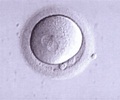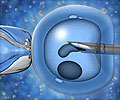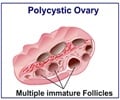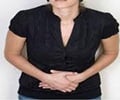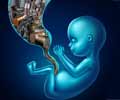Infertility is rising across Europe. Exposure to chemicals could be a major contributory factors, experts think.
Infertility is rising across Europe. Exposure to chemicals could be a major contributory factor, experts think.
Roughly one third of infertility remains 'unexplained,' a third is female-related - apart from the fact that women are trying for children later, sexually transmitted infections and polycystic ovary syndrome (PCOS) are on the rise - and the rest is male-related.There is an alarming drop in sperm counts. 'Something has changed in the past 20 or 30 years,' says Allan Pacey, the secretary of the British Fertility Society. 'We don't know what it is, but we need to be very concerned.'
Many modern-day habits are known to play a part - drinking, smoking and overeating for example. What we don't know is whether there's something else going on - in the air we breathe, water we drink and food we eat. The thousands of invisible chemicals that have poured into our world since the Second World War to make life non-breakable, non-stick and flame-resistant are being linked to miscarriage, PCOS, endometriosis, and low sperm counts - as well as testicular cancer, breast cancer and prostate cancer.
Shanna Swan, an epidemiologist at the University of Rochester School of Medicine & Dentistry in America, has spent the past 20 years studying environmental reproductive risks. 'There's no question now that chemical exposures impair fertility,' she says. 'We have 80,000 chemicals in circulation and when we look we see strong evidence that comes out constantly in scientific journals and in small conferences. Yet somehow we haven't reached the tipping point where people take notice. With global warming, it took 20 years. The American surgeon general said in 1964 that cigarettes caused cancer. How long did that take to get around? Maybe it takes a disaster - and I think impairing our ability to reproduce is potentially the most serious disaster there is.'
Two highly ubiquitous chemicals, phthalates (the 'ph' is silent) and bisphenol A, are the cause of most concern. Both chemicals are everywhere - tin cans, baby bottles, water bottles, CDs, plastic toys, the list is endless - and because of their 'leachy' nature (they're not very good at binding to their products) they are in us, too. In a study by Shanna Swan of mothers and babies, all the babies had measurable phthalate levels - and those exposed to the most baby-care products had the highest. Often described as 'endocrine disrupters', phthalates mimic the female hormone oestrogen, so could play havoc with hormones and reproductive systems - particularly in men.
'There's good evidence that sperm counts are falling and that something environmental is going on,' confirms Pacey. Male infertility is now the reason for half of British couples having IVF. While our grandfathers probably had a sperm count of about 120 million in one millilitre of seminal fluid, the average male sperm count now stands at about 60 million. (Anything less than 25/30 million is classified as infertile.) At the same time testicular cancer, which is linked to low sperm counts, is rising fast.
Advertisement
Richard Sharpe, from the Medical Research Council's Human Reproductive Sciences Unit, agrees that there's likely to be an environmental link to infertility. Sharpe is studying testicular dysgenesis syndrome (TDS), an increasingly common reproductive disorder in boys. TDS, which can result in the testes failing to descend and the urethra opening being located on the wrong part of the penis, is linked to low sperm counts in adulthood.
Advertisement
Frederick Vom Saal, a professor of biological sciences at the University of Missouri, has conducted similar experiments with bisphenol A and found that, even in minute doses, it causes reproductive disorders and cancers of the uterus, breast and prostate in mice. Other studies have linked it to PCOS and recurrent miscarriage.
Vom Saal himself is sufficiently concerned to have installed a filter to ensure his home supply of water is bisphenol A-free. His family do not eat or drink out of cans (the chemical lines them) or plastic containers. 'Bisphenol A should not be in food or beverage contact products,' he says. 'Japan banned it from food and drink cans a decade ago.'
Part of the difficulty in knowing whether or not to be worried is that countries - and even individual cities in America - have all assessed the dangers differently. San Francisco banned bisphenol A from children's products last summer - but this was repealed after chemical and toy companies filed lawsuits. The European Food Safety Authority has judged it safe for use in food application while, last year, the Canadian government identified it as 'inherently toxic' and in need of further investigation. Meanwhile, the European Parliament has banned three forms of phthalates from toys and childcare items and restricted the use of three others.
In June 2007 the European Union passed probably the biggest piece of environmental legislation ever, Reach, which requires the chemical industry to register any chemical used in the EU, evaluate it and seek authorisation to use it. About 30,000 chemicals will have to go through this process. Finally the onus is on the chemical industry to test its products and reveal evidence of safety.
Steve Elliott, the chief executive of the Chemical Industries Association, says it's important to maintain perspective. 'The presence of a chemical is a blade of grass in a football field. We need to understand there's more danger to our children when they cross the road for school in the morning. In life there are risks, trade-offs - we need to make choices.'
Swan thinks the only way the industry will change is if consumers understand their options. 'If consumer pressure was there, if we knew what to look for on a label, the industry would have to find safer alternatives.'
In fact, this is slowly happening. Bisphenol A-free baby bottles and beakers are available online. Wooden toys are growing ever more popular. You can, if you look, find phthalate-free skin products, teething rings, changing mats, sex toys, you name it. There are countless more 'precautions' you can take - flasks instead of water bottles, brown paper for sandwiches instead of plastic wrapping, jars instead of plastic containers. But would this be a pointless drop in our ocean of plastic? wonders Anna Moore, writing in a magazine supplement of Sunday Telegraph.
Source-Medindia
GPL/L

